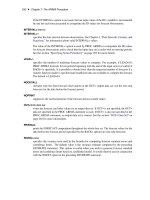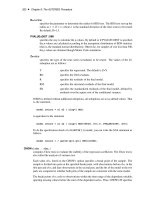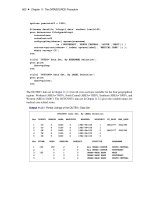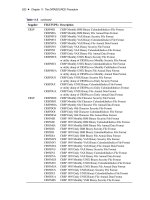SAS/ETS 9.22 User''''s Guide 26 doc
Bạn đang xem bản rút gọn của tài liệu. Xem và tải ngay bản đầy đủ của tài liệu tại đây (279.05 KB, 10 trang )
242 ✦ Chapter 7: The ARIMA Procedure
If the INTERVAL= option is not used, the last input value of the ID= variable is incremented
by one for each forecast period to extrapolate the ID values for forecast observations.
INTERVAL=interval
INTERVAL=n
specifies the time interval between observations. See Chapter 4, “Date Intervals, Formats, and
Functions,” for information about valid INTERVAL= values.
The value of the INTERVAL= option is used by PROC ARIMA to extrapolate the ID values
for forecast observations and to check that the input data are in order with no missing periods.
See the section “Specifying Series Periodicity” on page 263 for more details.
LEAD=n
specifies the number of multistep forecast values to compute. For example, if LEAD=10,
PROC ARIMA forecasts for ten periods beginning with the end of the input series (or earlier if
BACK= is specified). It is possible to obtain fewer than the requested number of forecasts if a
transfer function model is specified and insufficient data are available to compute the forecast.
The default is LEAD=24.
NOOUTALL
includes only the final forecast observations in the OUT= output data set, not the one-step
forecasts for the data before the forecast period.
NOPRINT
suppresses the normal printout of the forecast and associated values.
OUT=SAS-data-set
writes the forecast (and other values) to an output data set. If OUT= is not specified, the OUT=
data set specified in the PROC ARIMA statement is used. If OUT= is also not specified in the
PROC ARIMA statement, no output data set is created. See the section “OUT= Data Set” on
page 265 for more information.
PRINTALL
prints the FORECAST computation throughout the whole data set. The forecast values for the
data before the forecast period (specified by the BACK= option) are one-step forecasts.
SIGSQ=value
specifies the variance term used in the formula for computing forecast standard errors and
confidence limits. The default value is the variance estimate computed by the preceding
ESTIMATE statement. This option is useful when you wish to generate forecast standard
errors and confidence limits based on a published model. It would often be used in conjunction
with the NOEST option in the preceding ESTIMATE statement.
Details: ARIMA Procedure ✦ 243
Details: ARIMA Procedure
The Inverse Autocorrelation Function
The sample inverse autocorrelation function (SIACF) plays much the same role in ARIMA modeling
as the sample partial autocorrelation function (SPACF), but it generally indicates subset and seasonal
autoregressive models better than the SPACF.
Additionally, the SIACF can be useful for detecting over-differencing. If the data come from a
nonstationary or nearly nonstationary model, the SIACF has the characteristics of a noninvertible
moving-average. Likewise, if the data come from a model with a noninvertible moving average, then
the SIACF has nonstationary characteristics and therefore decays slowly. In particular, if the data
have been over-differenced, the SIACF looks like a SACF from a nonstationary process.
The inverse autocorrelation function is not often discussed in textbooks, so a brief description is
given here. More complete discussions can be found in Cleveland (1972), Chatfield (1980), and
Priestly (1981).
Let W
t
be generated by the ARMA(p, q ) process
.B/W
t
D Â.B/a
t
where
a
t
is a white noise sequence. If
Â
(
B
) is invertible (that is, if
Â
considered as a polynomial in
B has no roots less than or equal to 1 in magnitude), then the model
Â.B/Z
t
D .B/a
t
is also a valid ARMA(q,p ) model. This model is sometimes referred to as the dual model. The
autocorrelation function (ACF) of this dual model is called the inverse autocorrelation function
(IACF) of the original model.
Notice that if the original model is a pure autoregressive model, then the IACF is an ACF that
corresponds to a pure moving-average model. Thus, it cuts off sharply when the lag is greater than p;
this behavior is similar to the behavior of the partial autocorrelation function (PACF).
The sample inverse autocorrelation function (SIACF) is estimated in the ARIMA procedure by the
following steps. A high-order autoregressive model is fit to the data by means of the Yule-Walker
equations. The order of the autoregressive model used to calculate the SIACF is the minimum of
the NLAG= value and one-half the number of observations after differencing. The SIACF is then
calculated as the autocorrelation function that corresponds to this autoregressive operator when
treated as a moving-average operator. That is, the autoregressive coefficients are convolved with
themselves and treated as autocovariances.
Under certain conditions, the sampling distribution of the SIACF can be approximated by the
sampling distribution of the SACF of the dual model (Bhansali 1980). In the plots generated by
ARIMA, the confidence limit marks (.) are located at
˙2=
p
n
. These limits bound an approximate
95% confidence interval for the hypothesis that the data are from a white noise process.
244 ✦ Chapter 7: The ARIMA Procedure
The Partial Autocorrelation Function
The approximation for a standard error for the estimated partial autocorrelation function at lag k is
based on a null hypothesis that a pure autoregressive Gaussian process of order k–1 generated the
time series. This standard error is
1=
p
n
and is used to produce the approximate 95% confidence
intervals depicted by the dots in the plot.
The Cross-Correlation Function
The autocorrelation and partial and inverse autocorrelation functions described in the preceding
sections help when you want to model a series as a function of its past values and past random errors.
When you want to include the effects of past and current values of other series in the model, the
correlations of the response series and the other series must be considered.
The CROSSCORR= option in the IDENTIFY statement computes cross-correlations of the VAR=
series with other series and makes these series available for use as inputs in models specified by later
ESTIMATE statements.
When the CROSSCORR= option is used, PROC ARIMA prints a plot of the cross-correlation
function for each variable in the CROSSCORR= list. This plot is similar in format to the other
correlation plots, but it shows the correlation between the two series at both lags and leads. For
example,
identify var=y crosscorr=x ;
plots the cross-correlation function of Y and X,
Cor.y
t
; x
ts
/
, for
s D L
to
L
, where
L
is the value
of the NLAG= option. Study of the cross-correlation functions can indicate the transfer functions
through which the input series should enter the model for the response series.
The cross-correlation function is computed after any specified differencing has been done. If
differencing is specified for the VAR= variable or for a variable in the CROSSCORR= list, it is the
differenced series that is cross-correlated (and the differenced series is processed by any following
ESTIMATE statement).
For example,
identify var=y(1) crosscorr=x(1);
computes the cross-correlations of the changes in Y with the changes in X. When differencing is
specified, the subsequent ESTIMATE statement models changes in the variables rather than the
variables themselves.
The ESACF Method ✦ 245
The ESACF Method
The extended sample autocorrelation function (ESACF) method can tentatively identify the orders
of a stationary or nonstationary ARMA process based on iterated least squares estimates of the
autoregressive parameters. Tsay and Tiao (1984) proposed the technique, and Choi (1992) provides
useful descriptions of the algorithm.
Given a stationary or nonstationary time series
fz
t
W 1 Ä t Ä ng
with mean corrected form
Qz
t
D z
t
z
with a true autoregressive order of
p C d
and with a true moving-average order
of
q
, you can use the ESACF method to estimate the unknown orders
p C d
and
q
by analyzing the
autocorrelation functions associated with filtered series of the form
w
.m;j /
t
D
O
ˆ
.m;j /
.B/Qz
t
D Qz
t
m
X
iD1
O
.m;j /
i
Qz
ti
where
B
represents the backshift operator, where
m D p
mi n
; : : :; p
max
are the autoregressive test
orders, where
j D q
mi n
C 1; : : :; q
max
C 1
are the moving-average test orders, and where
O
.m;j /
i
are the autoregressive parameter estimates under the assumption that the series is an ARMA(
m; j
)
process.
For purely autoregressive models (
j D 0
), ordinary least squares (OLS) is used to consistently
estimate
O
.m;0/
i
. For ARMA models, consistent estimates are obtained by the iterated least squares
recursion formula, which is initiated by the pure autoregressive estimates:
O
.m;j /
i
D
O
.mC1;j 1/
i
O
.m;j 1/
i1
O
.mC1;j 1/
mC1
O
.m;j 1/
m
The
j
th lag of the sample autocorrelation function of the filtered series
w
.m;j /
t
is the extended sample
autocorrelation function, and it is denoted as r
j.m/
D r
j
.w
.m;j /
/.
The standard errors of
r
j.m/
are computed in the usual way by using Bartlett’s approximation of the
variance of the sample autocorrelation function, var.r
j.m/
/ .1 C
P
j 1
tD1
r
2
j
.w
.m;j /
//.
If the true model is an ARMA (
p C d; q
) process, the filtered series
w
.m;j /
t
follows an MA(
q
) model
for j q so that
r
j.pCd /
0 j > q
r
j.pCd /
¤ 0 j D q
Additionally, Tsay and Tiao (1984) show that the extended sample autocorrelation satisfies
r
j.m/
0 j q > m p d Ä 0
r
j.m/
¤ c.m p d; j q/ 0 Ä j q Ä m p d
where
c.m p d; j q/
is a nonzero constant or a continuous random variable bounded by –1
and 1.
246 ✦ Chapter 7: The ARIMA Procedure
An ESACF table is then constructed by using the
r
j.m/
for
m D p
mi n;
: : :; p
max
and
j D q
mi n
C 1; : : :; q
max
C 1
to identify the ARMA orders (see Table 7.4). The orders are
tentatively identified by finding a right (maximal) triangular pattern with vertices located at
.p C d; q/
and
.p C d; q
max
/
and in which all elements are insignificant (based on asymptotic
normality of the autocorrelation function). The vertex
.p C d; q/
identifies the order. Table 7.5
depicts the theoretical pattern associated with an ARMA(1,2) series.
Table 7.4 ESACF Table
MA
AR 0 1 2 3
0 r
1.0/
r
2.0/
r
3.0/
r
4.0/
1 r
1.1/
r
2.1/
r
3.1/
r
4.1/
2 r
1.2/
r
2.2/
r
3.2/
r
4.2/
3 r
1.3/
r
2.3/
r
3.3/
r
4.3/
Table 7.5 Theoretical ESACF Table for an ARMA(1,2) Series
MA
AR 0 1 2 3 4 5 6 7
0 * X X X X X X X
1 * X 0 0 0 0 0 0
2 * X X 0 0 0 0 0
3 * X X X 0 0 0 0
4 * X X X X 0 0 0
X = significant terms
0 = insignificant terms
* = no pattern
The MINIC Method
The minimum information criterion (MINIC) method can tentatively identify the order of a stationary
and invertible ARMA process. Note that Hannan and Rissannen (1982) proposed this method, and
Box, Jenkins, and Reinsel (1994) and Choi (1992) provide useful descriptions of the algorithm.
Given a stationary and invertible time series
fz
t
W 1 Ä t Ä ng
with mean corrected form
Qz
t
D z
t
z
with a true autoregressive order of
p
and with a true moving-average order of
q
, you can use the
MINIC method to compute information criteria (or penalty functions) for various autoregressive and
moving average orders. The following paragraphs provide a brief description of the algorithm.
The MINIC Method ✦ 247
If the series is a stationary and invertible ARMA(p, q ) process of the form
ˆ
.p;q/
.B/Qz
t
D ‚
.p;q/
.B/
t
the error series can be approximated by a high-order AR process
O
t
D
O
ˆ
.p
;q/
.B/Qz
t
t
where the parameter estimates
O
ˆ
.p
;q/
are obtained from the Yule-Walker estimates. The choice
of the autoregressive order
p
is determined by the order that minimizes the Akaike information
criterion (AIC) in the range p
;mi n
Ä p
Ä p
;max
AIC.p
; 0/ D ln. Q
2
.p
;0/
/ C 2.p
C 0/=n
where
Q
2
.p
;0/
D
1
n
n
X
tDp
C1
O
2
t
Note that Hannan and Rissannen (1982) use the Bayesian information criterion (BIC) to determine
the autoregressive order used to estimate the error series. Box, Jenkins, and Reinsel (1994) and
Choi (1992) recommend the AIC.
Once the error series has been estimated for autoregressive test order
m D p
mi n
; : : :; p
max
and for
moving-average test order
j D q
mi n
; : : :; q
max
, the OLS estimates
O
ˆ
.m;j /
and
O
‚
.m;j /
are computed
from the regression model
Qz
t
D
m
X
iD1
.m;j /
i
Qz
ti
C
j
X
kD1
Â
.m;j /
k
O
tk
C error
From the preceding parameter estimates, the BIC is then computed
BIC.m; j / D ln. Q
2
.m;j /
/ C 2.m C j /ln.n/=n
where
Q
2
.m;j /
D
1
n
n
X
tDt
0
0
@
Qz
t
m
X
iD1
.m;j /
i
Qz
ti
C
j
X
kD1
Â
.m;j /
k
O
tk
1
A
where t
0
D p
C max.m; j /.
A MINIC table is then constructed using
BIC.m; j /
; see Table 7.6. If
p
max
> p
;mi n
, the preceding
regression might fail due to linear dependence on the estimated error series and the mean-corrected
series. Values of
BIC.m; j /
that cannot be computed are set to missing. For large autoregressive
and moving-average test orders with relatively few observations, a nearly perfect fit can result. This
condition can be identified by a large negative BIC.m; j / value.
248 ✦ Chapter 7: The ARIMA Procedure
Table 7.6 MINIC Table
MA
AR 0 1 2 3
0 BIC.0; 0/ BIC.0; 1/ BIC.0; 2/ BIC.0; 3/
1 BIC.1; 0/ BIC.1; 1/ BIC.1; 2/ BIC.1; 3/
2 BIC.2; 0/ BIC.2; 1/ BIC.2; 2/ BIC.2; 3/
3 BIC.3; 0/ BIC.3; 1/ BIC.3; 2/ BIC.3; 3/
The SCAN Method
The smallest canonical (SCAN) correlation method can tentatively identify the orders of a stationary
or nonstationary ARMA process. Tsay and Tiao (1985) proposed the technique, and Box, Jenkins,
and Reinsel (1994) and Choi (1992) provide useful descriptions of the algorithm.
Given a stationary or nonstationary time series
fz
t
W 1 Ä t Ä ng
with mean corrected form
Qz
t
D z
t
z
with a true autoregressive order of
p C d
and with a true moving-average order
of
q
, you can use the SCAN method to analyze eigenvalues of the correlation matrix of the ARMA
process. The following paragraphs provide a brief description of the algorithm.
For autoregressive test order
m D p
mi n
; : : :; p
max
and for moving-average test order
j D q
mi n
; : : :; q
max
, perform the following steps.
1. Let Y
m;t
D .Qz
t
; Qz
t1
; : : :; Qz
tm
/
0
. Compute the following .m C1/ .m C 1/ matrix
O
ˇ.m; j C 1/ D
X
t
Y
m;t j 1
Y
0
m;t j 1
!
1
X
t
Y
m;t j 1
Y
0
m;t
!
O
ˇ
.m; j C 1/ D
X
t
Y
m;t
Y
0
m;t
!
1
X
t
Y
m;t
Y
0
m;t j 1
!
O
A
.m; j / D
O
ˇ
.m; j C 1/
O
ˇ.m; j C 1/
where t ranges from j C m C 2 to n.
2.
Find the smallest eigenvalue,
O
.m; j /
, of
O
A
.m; j /
and its corresponding normalized eigen-
vector,
ˆ
m;j
D .1;
.m;j /
1
;
.m;j /
2
; : : : ;
.m;j /
m
/
. The squared canonical correlation
estimate is
O
.m; j /.
3.
Using the
ˆ
m;j
as AR(
m
) coefficients, obtain the residuals for
t D j C m C 1
to
n
, by
following the formula: w
.m;j /
t
D Qz
t
.m;j /
1
Qz
t1
.m;j /
2
Qz
t2
: : :
.m;j /
m
Qz
tm
.
4.
From the sample autocorrelations of the residuals,
r
k
.w/
, approximate the standard error of
the squared canonical correlation estimate by
var.
O
.m; j /
1=2
/ d.m; j /=.n m j /
The SCAN Method ✦ 249
where d.m; j / D .1 C2
P
j 1
iD1
r
k
.w
.m;j /
//.
The test statistic to be used as an identification criterion is
c.m; j / D .n m j /ln.1
O
.m; j /=d.m; j //
which is asymptotically
2
1
if
m D p C d
and
j q
or if
m p C d
and
j D q
. For
m > p
and
j < q
, there is more than one theoretical zero canonical correlation between
Y
m;t
and
Y
m;t j 1
.
Since the
O
.m; j /
are the smallest canonical correlations for each
.m; j /
, the percentiles of
c.m; j /
are less than those of a
2
1
; therefore, Tsay and Tiao (1985) state that it is safe to assume a
2
1
. For
m < p and j < q, no conclusions about the distribution of c.m; j / are made.
A SCAN table is then constructed using
c.m; j /
to determine which of the
O
.m; j /
are significantly
different from zero (see Table 7.7). The ARMA orders are tentatively identified by finding a
(maximal) rectangular pattern in which the
O
.m; j /
are insignificant for all test orders
m p C d
and
j q
. There may be more than one pair of values (
p C d; q
) that permit such a rectangular
pattern. In this case, parsimony and the number of insignificant items in the rectangular pattern
should help determine the model order. Table 7.8 depicts the theoretical pattern associated with an
ARMA(2,2) series.
Table 7.7 SCAN Table
MA
AR 0 1 2 3
0 c.0; 0/ c.0; 1/ c.0; 2/ c.0; 3/
1 c.1; 0/ c.1; 1/ c.1; 2/ c.1; 3/
2 c.2; 0/ c.2; 1/ c.2; 2/ c.2; 3/
3 c.3; 0/ c.3; 1/ c.3; 2/ c.3; 3/
Table 7.8 Theoretical SCAN Table for an ARMA(2,2) Series
MA
AR 0 1 2 3 4 5 6 7
0 * X X X X X X X
1 * X X X X X X X
2 * X 0 0 0 0 0 0
3 * X 0 0 0 0 0 0
4 * X 0 0 0 0 0 0
X = significant terms
0 = insignificant terms
* = no pattern
250 ✦ Chapter 7: The ARIMA Procedure
Stationarity Tests
When a time series has a unit root, the series is nonstationary and the ordinary least squares (OLS)
estimator is not normally distributed. Dickey (1976) and Dickey and Fuller (1979) studied the
limiting distribution of the OLS estimator of autoregressive models for time series with a simple unit
root. Dickey, Hasza, and Fuller (1984) obtained the limiting distribution for time series with seasonal
unit roots. Hamilton (1994) discusses the various types of unit root testing.
For a description of Dickey-Fuller tests, see the section “PROBDF Function for Dickey-Fuller
Tests” on page 162 in Chapter 5. See Chapter 8, “The AUTOREG Procedure,” for a description of
Phillips-Perron tests.
The random-walk-with-drift test recommends whether or not an integrated times series has a drift
term. Hamilton (1994) discusses this test.
Prewhitening
If, as is usually the case, an input series is autocorrelated, the direct cross-correlation function
between the input and response series gives a misleading indication of the relation between the input
and response series.
One solution to this problem is called prewhitening. You first fit an ARIMA model for the input
series sufficient to reduce the residuals to white noise; then, filter the input series with this model
to get the white noise residual series. You then filter the response series with the same model and
cross-correlate the filtered response with the filtered input series.
The ARIMA procedure performs this prewhitening process automatically when you precede the
IDENTIFY statement for the response series with IDENTIFY and ESTIMATE statements to fit a
model for the input series. If a model with no inputs was previously fit to a variable specified by the
CROSSCORR= option, then that model is used to prewhiten both the input series and the response
series before the cross-correlations are computed for the input series.
For example,
proc arima data=in;
identify var=x;
estimate p=1 q=1;
identify var=y crosscorr=x;
run;
Both X and Y are filtered by the ARMA(1,1) model fit to X before the cross-correlations are
computed.
Note that prewhitening is done to estimate the cross-correlation function; the unfiltered series are
used in any subsequent ESTIMATE or FORECAST statements, and the correlation functions of Y
with its own lags are computed from the unfiltered Y series. But initial values in the ESTIMATE
Identifying Transfer Function Models ✦ 251
statement are obtained with prewhitened data; therefore, the result with prewhitening can be different
from the result without prewhitening.
To suppress prewhitening for all input variables, use the CLEAR option in the IDENTIFY statement
to make PROC ARIMA disregard all previous models.
Prewhitening and Differencing
If the VAR= and CROSSCORR= options specify differencing, the series are differenced before the
prewhitening filter is applied. When the differencing lists specified in the VAR= option for an input
and in the CROSSCORR= option for that input are not the same, PROC ARIMA combines the two
lists so that the differencing operators used for prewhitening include all differences in either list (in
the least common multiple sense).
Identifying Transfer Function Models
When identifying a transfer function model with multiple input variables, the cross-correlation
functions can be misleading if the input series are correlated with each other. Any dependencies
among two or more input series will confound their cross-correlations with the response series.
The prewhitening technique assumes that the input variables do not depend on past values of the
response variable. If there is feedback from the response variable to an input variable, as evidenced
by significant cross-correlation at negative lags, both the input and the response variables need to be
prewhitened before meaningful cross-correlations can be computed.
PROC ARIMA cannot handle feedback models. The STATESPACE and VARMAX procedures are
more appropriate for models with feedback.
Missing Values and Autocorrelations
To compute the sample autocorrelation function when missing values are present, PROC ARIMA uses
only crossproducts that do not involve missing values and employs divisors that reflect the number
of crossproducts used rather than the total length of the series. Sample partial autocorrelations and
inverse autocorrelations are then computed by using the sample autocorrelation function. If necessary,
a taper is employed to transform the sample autocorrelations into a positive definite sequence before
calculating the partial autocorrelation and inverse correlation functions. The confidence intervals
produced for these functions might not be valid when there are missing values. The distributional
properties for sample correlation functions are not clear for finite samples. See Dunsmuir (1984) for
some asymptotic properties of the sample correlation functions.









